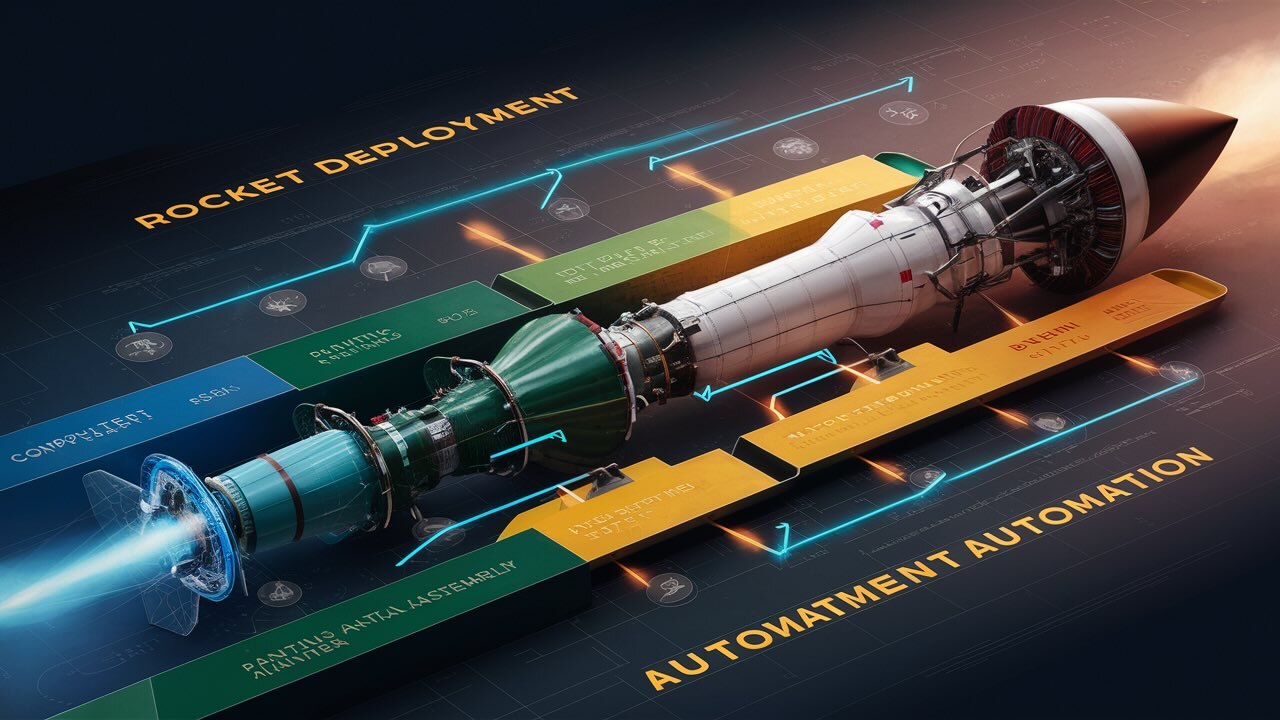Deployment Automation: A Quick Overview
Deployment automation is the process of using software tools and systems to automatically move code changes from one software environment to another. This eliminates the need for manual software releases, which can be time-consuming, error-prone, and inefficient.
How Does It Work?
Essentially, deployment automation creates a pipeline that takes code from development through testing, staging, and finally to production. This pipeline is triggered by events like code commits or merge requests, and it automates tasks such as:
- Building the code
- Running tests
- Deploying to different environments
- Configuring infrastructure
- Monitoring application performance
Benefits of Deployment Automation
- Speed: Faster time-to-market for new features and updates.
- Reliability: Reduces human error and ensures consistent deployments.
- Efficiency: Streamlines the development and release process.
- Scalability: Handles increased deployment frequency and complexity.
- Improved Quality: Early detection of issues through automated testing.
Key Components
- Continuous Integration (CI): Automatically builds and tests code changes.
- Continuous Delivery (CD): Automatically deploys code to various environments.
- Configuration Management: Manages infrastructure and application configurations.
- Deployment Tools: Software tools that orchestrate the deployment process.
Common Challenges in Deployment Automation
While deployment automation offers significant benefits, it's not without its challenges:
- Tool Selection: Choosing the right tools for your specific needs can be overwhelming. Each tool has its strengths and weaknesses, and integrating them effectively can be complex.
- Integration with Existing Systems: Integrating deployment automation with existing infrastructure, development processes, and tools can be time-consuming and disruptive.
- Configuration Management: Managing complex configurations across different environments can be error-prone. Ensuring consistency and accuracy is crucial.
- Security: Protecting sensitive data and preventing unauthorised access during deployment is essential.
- Team Adoption: Overcoming resistance to change and ensuring team members understand the benefits of automation can be challenging.
- Complexity: Building and maintaining complex deployment pipelines requires specialized skills and knowledge.
Best Practices for Deployment Automation
To address these challenges and maximize the benefits of deployment automation, consider these best practices:
- Start Small: Begin with a simple project to gain experience and build confidence.
- Choose the Right Tools: Select tools that align with your team's skills and project requirements.
- Automate Everything Possible: Identify manual steps in the deployment process and automate them.
- Infrastructure as Code (IaC): Use IaC to manage infrastructure configurations consistently.
- Continuous Testing: Incorporate thorough testing at every stage of the pipeline.
- Version Control: Use version control for both code and infrastructure configurations.
- Monitoring and Logging: Implement robust monitoring and logging to track deployment performance and troubleshoot issues.
- Rollback Strategy: Have a well-defined rollback plan in case of deployment failures.
- Security First: Integrate security checks into the pipeline to protect sensitive data.
- Continuous Improvement: Regularly review and refine your deployment process based on feedback and metrics.
By following these best practices and addressing common challenges, you can build a reliable and efficient deployment automation pipeline that delivers value to your organization.
Executing Automated Deployment with DeployHQ
DeployHQ is a popular platform for automating deployments. Here's a basic outline of how to set up and execute an automated deployment:
1. Create a DeployHQ Project
- Sign up for a DeployHQ account.
- Create a new project and specify your repository (GitHub, GitLab, Bitbucket, etc.).
- Add your deployment servers (SSH, SFTP, FTP, FTPS and more).
2. Configure Deployment Steps
- Define the steps involved in your deployment process, such as:
- Cloning the repository
- Installing dependencies
- Building the application
- Deploying files
- Restarting services or running migrations
- DeployHQ offers a simple interface to define these steps using scripts or pre-built actions, as described here.
3. Set Up Automatic Deployments
- Navigate to the "Automatic Deployments" section of your project.
- Copy the provided webhook URL.
- Add this webhook to your repository settings.
- Enable automatic deployments for specific servers or groups.
- More info about it in our blogpost here.
Deployment Automation: Frequently Asked Questions
- What is deployment automation? Deployment automation is the process of using software tools to automatically move code changes from one software environment to another. It eliminates manual intervention, reducing errors and improving efficiency.
- What are the benefits of deployment automation? Benefits include faster time-to-market, reduced human error, increased efficiency, scalability, and improved quality through automated testing.
- What are the key components of deployment automation? Key components are Continuous Integration (CI), Continuous Delivery (CD), configuration management, and deployment tools.
- How does deployment automation differ from continuous integration and continuous delivery? While CI focuses on building and testing code, CD focuses on deploying it. Deployment automation is a subset of CD, specifically automating the deployment process.
What are the key tools for deployment automation?
The main tools for deployment automation are configuration management tools, CI/CD, and version control systems. Other key tools include:
- Terraform: Enables infrastructure as code for consistent, scalable provisioning. What's IaC?
- Docker: Containerizes applications for smooth deployment across environments. Not sure What's Docker?
- Ansible: Simplifies complex deployments through human-readable automation.
